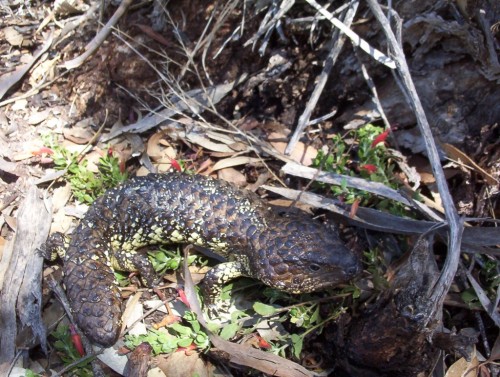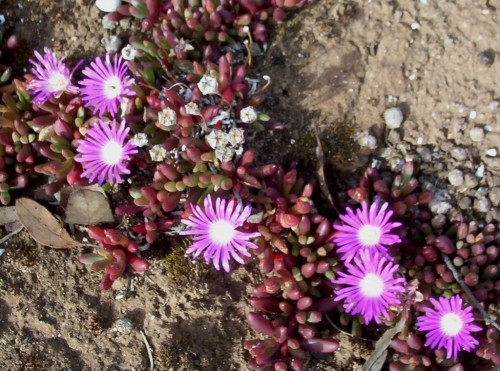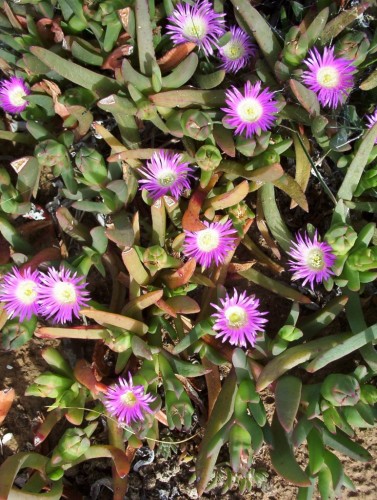Eremophila glabra prostrate, red form
I was watching the birds in the bird bath and spotted this small Stumpy tail Lizard (Shingle Back Lizard). It was munching on the red flowers of this very hardy ground cover Eremophila. It is not just red flowers that they like to eat. I have often seen them eating the yellow and orange flowers of Gazanias which have become naturalised around here. They also absolutely love to eat strawberries.
Eremophila flowers have a sweet nectar in the base of the flowers.
This particular plant is very hardy to frost and drought conditions as well as highly alkaline soil.
Banksia ashbyi (Ashby’s Banksia)
I walked around the grounds of the campsite mentioned in the previous post, taking photos of plants in flower. A few years ago a small sheltered horseshoe shaped area of retreat was created with a large rockery forming the boundary. I found Banksia ashbyi flowering and looking surprisingly good, although I know this as one of the hardier Banksias.
This is a medium to tall shrub, 2-6m high and 2-4m wide. Leaves are 15-50cm long, with a deep saw toothed edge. The flower heads are bright orange. It needs very well drained soil in a warm climate. It is drought tolerant and frost hardy once established. This Banksia is one of those grown for the cut flower trade.
Chamelaucium (Geraldton Wax)
I’ve been to a Women’s Craft Camp this weekend indulging myself in some relaxing hand sewing while making a small sewing box called an etui. There were 72 women booked in at this camp called ‘El Shaddai’. The site is not far from the River Murray at Wellington SA and has been made attractive over the years with wind break plantings and gardens around the site.
I remember years ago when this site was begun how much difficulty there was in planting trees and shrubs. There is sheet limestone everywhere and planting holes were actually blasted.
Chamaelauciums (Geraldton Wax) have a habit of becoming a little yellow in the foliage when the soil alkalinity is too high. This one was looking very good.
The garden soil has certainly been improved and I was surprised to see a few plants there which usually take on a yellowish tone in the highly alkaline conditions actually coping well with the conditions. It proves that the high pH situation can be improved with some attention given to good garden practice. In this case, garden beds have been raised and composted materials added and mulch has been applied over the years.
.
Disphyma crassifolium (Rounded Noon-Flower)
The leaves seem to take on the reddish hew when it is in a dry position.
Carpobrotus rossii (Pig Face) In Flower
This is the flower of the succulent plant in the previous post. There were only a few isolated flowers on the plants near the nest. This is a useful plant. Not only is it useful and decorative in the garden, it is one of the bush tucker plants used by the local Aboriginal group. The leaves and fruits were used as a kind of relish to be eaten with meat. The juice from the leaves is also said to be an insect repellant. As with any new thing, a cautious test should be done before slathering one’s skin with the juice of an unknown plant.
I guess the same could be said for the plants in the Aloe family. Aloe Vera is good on a number of skin ailments but I am never sure which member of the species is the one to use.




